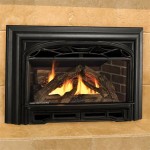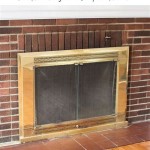Corner Fireplace Stone Ideas: Enhancing Your Living Space
A corner fireplace can serve as a compelling focal point in any room. It maximizes space utilization while adding warmth and aesthetic appeal. Employing stone as the primary material for a corner fireplace enhances its natural beauty and offers a timeless elegance that complements various interior design styles. The selection of the right stone can significantly impact the overall ambiance and value of a home. This article explores a range of corner fireplace stone ideas, providing insights into different stone types, design considerations, and practical applications to help inform decision-making for homeowners and design professionals.
Selecting the Right Stone Type for Your Corner Fireplace
The choice of stone for a corner fireplace depends on several factors, including the desired aesthetic, budget, and structural considerations. Different stone types offer distinct characteristics in terms of color, texture, durability, and maintenance requirements. Common options include natural stone varieties like granite, marble, limestone, slate, and fieldstone, as well as manufactured stone veneers, which offer a more cost-effective alternative.
Granite: Known for its exceptional durability and resistance to heat, granite is a popular choice for fireplaces. It comes in a wide range of colors and patterns, providing versatility in design. Granite is also relatively easy to clean and maintain, making it a practical option for high-use areas. Its inherent strength allows it to withstand the extreme temperatures associated with fireplaces without cracking or discoloration.
Marble: Marble exudes a sense of luxury and sophistication. Its smooth, polished surface and intricate veining patterns create a visually stunning effect. While marble is less heat-resistant than granite, it can still be used safely in fireplace surrounds with proper installation and maintenance. Marble requires regular sealing to protect it from staining and etching, especially if exposed to acidic substances. The elegance of marble elevates the overall design of the room, making it a statement piece.
Limestone: Limestone offers a more rustic and earthy aesthetic. Its porous texture and subtle color variations add warmth and character to a fireplace. Limestone is relatively soft compared to granite or marble, making it easier to shape and customize. However, its porous nature also means it is more susceptible to staining and requires regular sealing. Limestone is a good choice for homeowners seeking a natural and understated look.
Slate: Slate is a fine-grained metamorphic rock known for its durability and distinctive layered appearance. It is available in a range of colors, from dark gray to black, and its natural cleft surface adds texture and visual interest. Slate is heat-resistant and relatively easy to maintain, making it a practical choice for fireplaces. Its unique texture provides a tactile element to the design, enhancing its overall appeal.
Fieldstone: Fieldstone refers to naturally occurring stones found in fields and streams. These stones are typically irregular in shape and size, creating a rustic and organic look. Fieldstone fireplaces often evoke a sense of history and tradition. Working with fieldstone requires skilled craftsmanship to ensure proper installation and structural stability. The natural variations in color and texture make each fieldstone fireplace unique.
Manufactured Stone Veneer: Manufactured stone veneer, also known as cultured stone, is a composite material made to resemble natural stone. It is typically lighter and more affordable than natural stone, making it a popular choice for homeowners on a budget. Manufactured stone veneer is available in a wide range of styles and colors, mimicking the appearance of various natural stone types. It is relatively easy to install and requires minimal maintenance. While it may not have the same inherent durability as natural stone, manufactured stone veneer offers a cost-effective way to achieve a similar aesthetic.
When selecting a stone type, it is crucial to consider the overall design style of the room, as well as the functional requirements of the fireplace. The stone should complement the surrounding décor and provide adequate heat resistance and durability for its intended use.
Design Considerations for Corner Fireplace Stone Installation
Designing a corner fireplace with stone requires careful planning and attention to detail. Several factors should be considered to ensure a successful and aesthetically pleasing outcome. These include the size and shape of the fireplace, the orientation of the corner, the surrounding décor, and the desired style.
Size and Shape: The size of the fireplace should be proportionate to the size of the room. A large fireplace in a small room can feel overwhelming, while a small fireplace in a large room may get lost. The shape of the fireplace should also be considered, taking into account the architectural style of the room. Common shapes include rectangular, square, and curved designs. The stone should be cut and arranged to fit the dimensions of the fireplace seamlessly.
Corner Orientation: The orientation of the corner where the fireplace is located can impact the design. An inward-facing corner may benefit from a symmetrical design, while an outward-facing corner may require a more asymmetrical approach. The angle of the corner should also be considered when cutting and installing the stone. The goal is to create a visually balanced and harmonious design that complements the architecture of the room.
Surrounding Decor: The stone should complement the surrounding décor, including the wall color, flooring, and furniture. Consider the color palette and overall style of the room when selecting the stone. For example, a modern room may benefit from sleek, minimalist stone, while a rustic room may be better suited for natural, textured stone. The fireplace should seamlessly integrate into the existing décor, enhancing the overall aesthetic of the space.
Desired Style: The desired style of the fireplace should also be considered. Do you want a traditional, modern, rustic, or contemporary look? The stone should reflect the desired style. For example, a traditional fireplace may feature ornate details and classic stone patterns, while a modern fireplace may feature clean lines and minimalist stone arrangements. The style of the fireplace should be consistent with the overall design aesthetic of the room.
Mantel and Hearth: The mantel and hearth are important design elements of a fireplace. The mantel provides a decorative shelf above the fireplace, while the hearth provides a protective surface in front of the fireplace. The materials used for the mantel and hearth should complement the stone. Common options include wood, stone, and metal. The size and style of the mantel and hearth should be proportionate to the size and style of the fireplace.
Lighting: Lighting can enhance the beauty of the stone and create a warm and inviting atmosphere. Consider adding recessed lighting above the fireplace or sconces on either side. The lighting should highlight the texture and color of the stone, creating visual interest and depth. Dimmer switches can be used to adjust the lighting to create different moods.
Professional Installation: While DIY stone fireplace installation is possible, it is generally recommended to hire a professional contractor. Stone installation requires specialized skills and tools to ensure proper structural stability and aesthetic appeal. A professional contractor can help you select the right stone, design the fireplace, and install it safely and efficiently. Proper installation is crucial for the longevity and performance of the fireplace.
Practical Applications and Maintenance of Stone Fireplaces
Beyond aesthetics, practical considerations are essential when incorporating stone into a corner fireplace. These include installation techniques, safety measures, and ongoing maintenance to ensure the fireplace remains functional and visually appealing for years to come.
Installation Techniques: Proper installation is critical for the safety and longevity of a stone fireplace. The foundation must be strong and stable to support the weight of the stone. Mortar is used to adhere the stones together, creating a solid and durable structure. The mortar joints should be properly filled and finished to prevent water damage and ensure structural integrity. A professional installer will have the necessary skills and experience to ensure a safe and proper installation. Following building codes and safety regulations is paramount.
Safety Measures: Fire safety is a primary concern when installing a fireplace. The fireplace should be installed according to local building codes and safety regulations. A non-combustible hearth extension should be installed in front of the fireplace to protect the flooring from sparks and embers. A chimney liner should be installed to protect the chimney from corrosion and ensure proper ventilation. Regular inspections and maintenance are essential to prevent fire hazards and ensure the safe operation of the fireplace. Installing carbon monoxide detectors in the home is also highly recommended.
Cleaning and Maintenance: Regular cleaning and maintenance are essential to keep a stone fireplace looking its best. The stone should be cleaned regularly to remove soot, dust, and other debris. Use a soft brush and mild soap to clean the stone. Avoid using harsh chemicals or abrasive cleaners, as they can damage the stone. The mortar joints should also be cleaned regularly to prevent staining and mildew growth.
Sealing: Certain types of stone, such as limestone and marble, require regular sealing to protect them from staining and etching. A stone sealer should be applied according to the manufacturer's instructions. Sealing helps to prevent liquids from penetrating the stone, making it easier to clean and maintain. The frequency of sealing depends on the type of stone and the level of use. Consult with a stone professional to determine the best sealing schedule for your fireplace.
Repairs: Over time, stone fireplaces may require repairs due to cracks, chips, or other damage. Small cracks can often be repaired with epoxy or mortar patching. Larger cracks or damaged stones may require professional repair or replacement. It is important to address repairs promptly to prevent further damage and maintain the structural integrity of the fireplace. Regular inspections can help identify potential problems early on.
Professional Inspection: Annual professional inspections of the fireplace and chimney are recommended to ensure they are in good working condition. A certified chimney sweep can inspect the chimney for creosote buildup, cracks, and other damage. They can also clean the chimney to remove creosote and prevent fire hazards. Professional inspections can help identify potential problems and ensure the safe and efficient operation of the fireplace.
By understanding the different types of stone, considering the design implications, and adhering to proper installation and maintenance practices, homeowners can create a stunning and functional corner fireplace that enhances the beauty and value of their home.

Corner Fireplace Ideas Tags Diy Modern Home Design

Stone Fireplace Gallery Ideas For Your Home Corner Living Room Designs

Discover The 61 Best Corner Fireplace Designs In 2024 Stone Gas Electric

Faux Stone Corner Fireplace Genstone

Corner Stone Fireplace Designs Cornering The Market

Corner Stone Fireplace Mantel Idea

Corner Stone Fireplace Traditional Living Room Other By Select Homes Of Iowa Houzz Ie

Flaming Chichi Corner Fireplaces Heat Up Living Space Decor

Stone Fireplace Ideas For Cozy Comfort In The Home Town Country Living

32 Best Corner Fireplace Ideas For 2024 Decor Home Design
Related Posts








